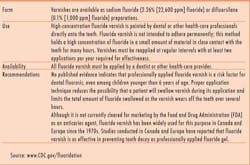A quick study on benefits of fluoride varnishes
By Noel Kelsch, RDHAP
Before speaking to a group of medical professionals at a symposium that focused on the quality of care patients receive, a question was delivered to me. The question was, “What is the difference between a health-care professional who utilizes up-to-date, evidence-based technologies and one who does not?”
My reply was simple. “About 15 minutes.”
Fifteen minutes is the average amount of time I spend a day researching the products and procedures that I use. Staying updated on these products and procedures makes all the difference in meeting patient needs and helping them obtain optimal oral health. Some people grab their morning coffee and the newspaper. I am a hibiscus tea and journal person myself.
One area that I recently spent the day learning about is fluoride varnish. I visited the booths at a dental meeting and asked for educational materials and samples of the varnish products they were promoting. This simple, yet complex item has been around for many years and has evolved in many areas. The challenge is to understand its use, the science behind it, as well as the most recent studies that have been conducted.
Patients have specific needs, and fluoride varnishes have evolved to meet those needs. The other issues that must be addressed before deciding which product to utilize is the ease of use, patient acceptance, and practicality of application. Just like we have a variety of restorative materials at our disposal, we should be looking at the elements of a variety of varnish materials and stock those that meet our patients’ needs.
Clients understanding the process
I always like to tell my clients what is really happening with the disease they are experiencing — or are susceptible to — and the health promotion and prevention process. I explain about the process of decay and how fluoride impacts decay in simple terms:
“Tooth decay is a transmittable infection caused by the bacteria that colonize on the teeth. These bacteria produce acid that literally dissolves enamel by demineralizing it. Our teeth are on a continuous cycle of demineralization and remineralization of tooth enamel. If the process is left unchecked, bacteria will eventually destroy the tooth structure.”
Fluoride is a naturally occurring mineral that has many aspects that are beneficial to the dentition. It is found in soil, fish, and even leafy green vegetables. The four main features of fluoride that help prevent decay are:
- Fluorides slow down demineralization and are a source of remineralization.
- Fluorides interfere with bacterial colonizing on teeth and reduce acid production, thus reducing demineralization.
- Fluoride is incorporated in tooth structure when small amounts are swallowed daily while the teeth are forming. Fluoride becomes concentrated in the outer enamel surfaces when applied after teeth erupt into the mouth.
- Dental plaque and saliva act as fluoride reservoirs to enhance the remineralization process.
Knowing the history of fluoride and why I choose to utilize varnish helps patients accept the treatment recommendations. I explain that in the 1960s to early 1970s, fluoride varnish came onto the market as an effort to overcome the shortfalls of existing fluoride methods of delivery. Fluoride gels and mouth rinses were the primary methods of delivery. Patient acceptance and compliance, as well as contact time, were major issues.1 In European nations, varnish was quickly accepted as a means of delivery. Remarkable results were seen in countries such as Denmark, which quickly adopted this science. The caries rate declined significantly as they utilized this method of delivery for children up to 18 years of age.2,3
Most fluoride varnishes are lacquers containing 5% sodium fluoride in a colophony/resin base. This resin hardens on the tooth as soon as it contacts saliva. The element of fluoride varnish that gives it such an advantage is that it increases the concentration of fluoride in the outer surface of teeth, enhancing fluoride uptake during early stages of demineralization. Because the varnish hardens so quickly, it allows a high concentration of fluoride to be in contact with tooth enamel for an extended period of time (about one to seven days). This is a much longer exposure compared with other past methods of delivering high-dose topical fluorides such as gels or foams, which is typically 10 to 15 minutes.4,5
The fluoride varnish method of delivery has great advantages for both children and the general population. The Centers for Disease Control and Prevention (CDC) recognizes that — although varnish is a Class II medical device that has been cleared by the Food and Drug Administration as a cavity liner and desensitizer — it has not been cleared for its anticaries properties.6
Both the CDC and the American Dental Association recommend six-month intervals for application for reducing or controlling dental caries in primary and permanent teeth for moderate and high-risk children. There has even been some benefit shown by a single application.7 Other studies have shown that more frequent applications (three-month intervals) may improve prevention even more. At this point, the optimal number has not been established.6 In most of the studies that have been conducted, varnish was applied at six-month intervals.3 Follow the package recommendations that come with the product that you choose to use.
Once clients understand the rationale behind fluoride varnishes, I then look at patients individually and choose the product that meets their needs. The basic formula for fluoride varnish has stayed the same over the years. Many companies, though, have embraced additions to the product that meet many oral health needs, such as antibacterials, additional desensitizers, remineralizers, as well as special attention to flavor and texture for the pediatric patient. These elements bring value through improvement in oral health and increased patient compliance.
In regard to flavor and texture, it is important with small children (and many adults!) to choose a product that has a good taste as well as texture. This product can make the difference between a positive dental experience and a negative dental experience for years to come. When you attend dental conventions, try the product on yourself. How does it feel? Is it too sticky? Does it take too long to harden? Does it have a bad taste or aftertaste? Would you want it in your mouth?
How easy is it to apply? Does it leave a sticky mess all over? Is it easy to find on the tray? Can you hold it while holding a mirror and managing a patient? How long does it take to harden? Is the application system easy to open, utilize, and hold? Does it have enough material to do a full mouth? How well does it flow? Does it remain on the teeth after application or shed off like gum? Evaluation of the product ahead of time will save you lots of time and headache in the chair!
Learning from hospice patients
One of the most rewarding aspects of my job is learning from my patients. Many clients are experiencing the impact of cancer. Working with hospice clients affords me the opportunity to select products that not only meet patient needs but can also directly impact the quality of their lives. Listening to patient needs and then finding the right product to match those needs can make all the difference in their comfort care.
These clients have helped me understand their needs. As they share their stories and experiences, I can match a product to those needs.
The information patients share with me leads to a fluoride varnish that I have found to be a great tool for comfort care and prevention. After listening to my patients’ needs and concerns, I needed a product that is easy to apply and does not require them to hold their mouths open for long periods of time. When the product hardens, it needs to be smooth because of the tendency of oral lesions to occur with these clients and the sensitivity of their oral mucosa. Many of these clients have a bad taste in their mouths because of their medications and xerostomia. Something that does not stick to oral mucosa and compound their xerostomia offers a great advantage. Many cancer treatments also impact remineralization, caries rate, and can increase sensitivity on the teeth. I wanted a product that could help with this area. Fluoride varnish alone is a major help, but I wanted something that would go beyond and aid in prevention.
I tried a variety of products and found one (MI Varnish, GC America) that contains bioavailable calcium and phosphate (Recaldent CPP-ACP). I had utilized MI Paste (GC America) and gum containing CPP-ACP with these clients in the past with great results. This fluoride product took the process to an even higher level.
Casein phosphopeptides (CPP) are pretty amazing. They occur naturally in milk casein. In the oral cavity, CPP binds to oral surfaces such as teeth, dentin, oral mucosa, and biofilm. Calcium and phosphate ions are the building blocks for healthy teeth, and MI Varnish delivers bioavailable calcium and phosphate ions into the saliva. The other thing I have found with patients experiencing head and neck cancer is that it really aids in digestion and impacts the patient’s ability to swallow. It coats mucosal lesions and aids in comfort. Amorphous calcium phosphate (ACP) is also a source of calcium and phosphate that strengthens enamel. Studies have shown that MI Varnish with Recaldent (CPP-ACP) enhances enamel acid resistance and boosts salivary fluoride levels. In addition, MI Varnish remains on the teeth longer than other fluoride varnishes with higher levels of fluoride and calcium released in the oral cavity.
This creamy, great-tasting product was so easy to apply bedside and hardened smoothly with a subtle, pleasant aftertaste. It was very flowable yet hardened quickly. It did not clump at all. The unit was easy to hold, and the brush was the best I have ever used!
Most patients claimed an immediate reduction of sensitivity because of the sealing and penetration of dental tubules with the CPP-ACP. My patients with oral lesions stated it was soothing. There was enough product in the easy-to-hold dispenser to do the entire mouth and then some! The clients loved the flavor and said it was much better than having to wear a mouth tray delivery system and deal with gels, foams, and pastes.
All of us have the ability to be up-to-date and meet patient needs with the most advanced technologies. Listen to your patients’ needs. Find time in your day to grab a cup of hibiscus tea and spend 15 minutes learning and growing as you stay up to date with products that aid in prevention, comfort, and health.
Noel Brandon Kelsch, RDHAP, is a syndicated columnist, writer, speaker, and cartoonist. She serves on the editorial review committee for the Organization for Safety, Asepsis and Prevention newsletter and has received many national awards. Kelsch owns her dental hygiene practice that focuses on access to care for all and helps facilitate the Simi Valley Free Dental Clinic. She has devoted much of her 35 years in dentistry to educating people about the devastating effects of methamphetamines and drug use. She is a past president of the California Dental Hygienists’ Association. She is also a speaker for GC America.
References
1. Beltrán-Aguilar ED, Goldstein JW, Lockwood SA. J Am Dent Assoc, Vol 131, No 5, 589-596. Fluoride Varnishes: A Review of Their Clinical Use, Cariostatic Mechanism, Efficacy and Safety.
2. Arnbjerg D. Use of professionally administered fluoride among Danish Children. Acata Odontaol Scand 1992:50:289-293.
3. Marinho VCC, Higgins JPT, Logan S, Sheiham A. Fluoride varnishes for preventing dental caries in children and adolescents. Cochrane Database of Systematic Reviews 2002, Issue 1. Art. No.: CD002279. DOI: 10.1002/14651858.CD002279.
4. Skold-Larsson K, Modeer T, Twetman S. Fluoride concentration in plaque in adolescents after topical application of different fluoride varnishes. Clin Oral Invest 2000; 4(1): 31-4.
5. Cate JM, Featherstone JDB. Mechanistic aspects of the interactions between fluoride and dental enamel. CRC Crit Rev Oral Biol Med 1991; 2: 283-296.
6. http://www.cdc.gov/fluoridation/other.htm#3 Accessed 1.2/2012.
7. Weintraub JA, Ramos-Gomez F, June B. Fluoride varnish efficacy in preventing early childhood caries. J Dent Res 2006; 85(2):172-176.
Past RDH Issues








